The Interplay of Organisational Culture and Human Resource Management
VerifiedAdded on 2020/01/28
|17
|6281
|60
Report
AI Summary
This report examines the crucial relationship between organisational culture and human resource management (HRM), particularly within the hospitality sector. It explores the impact of organisational culture on HRM practices, employee performance, and the achievement of organisational goals. The report defines organisational culture, its components, and its significance in HRM, referencing various models such as Charles Handy's cultural types and Hofstede's cultural dimensions. It further analyses the implications of considering organisational culture in HRM, including its benefits and potential drawbacks. The report provides insights into how different cultural dimensions influence HRM strategies. The research highlights that effective management of organisational culture is essential for fostering employee engagement, productivity, and overall organisational success. The report concludes with recommendations for aligning HRM practices with the prevailing organisational culture to enhance performance and achieve strategic objectives.
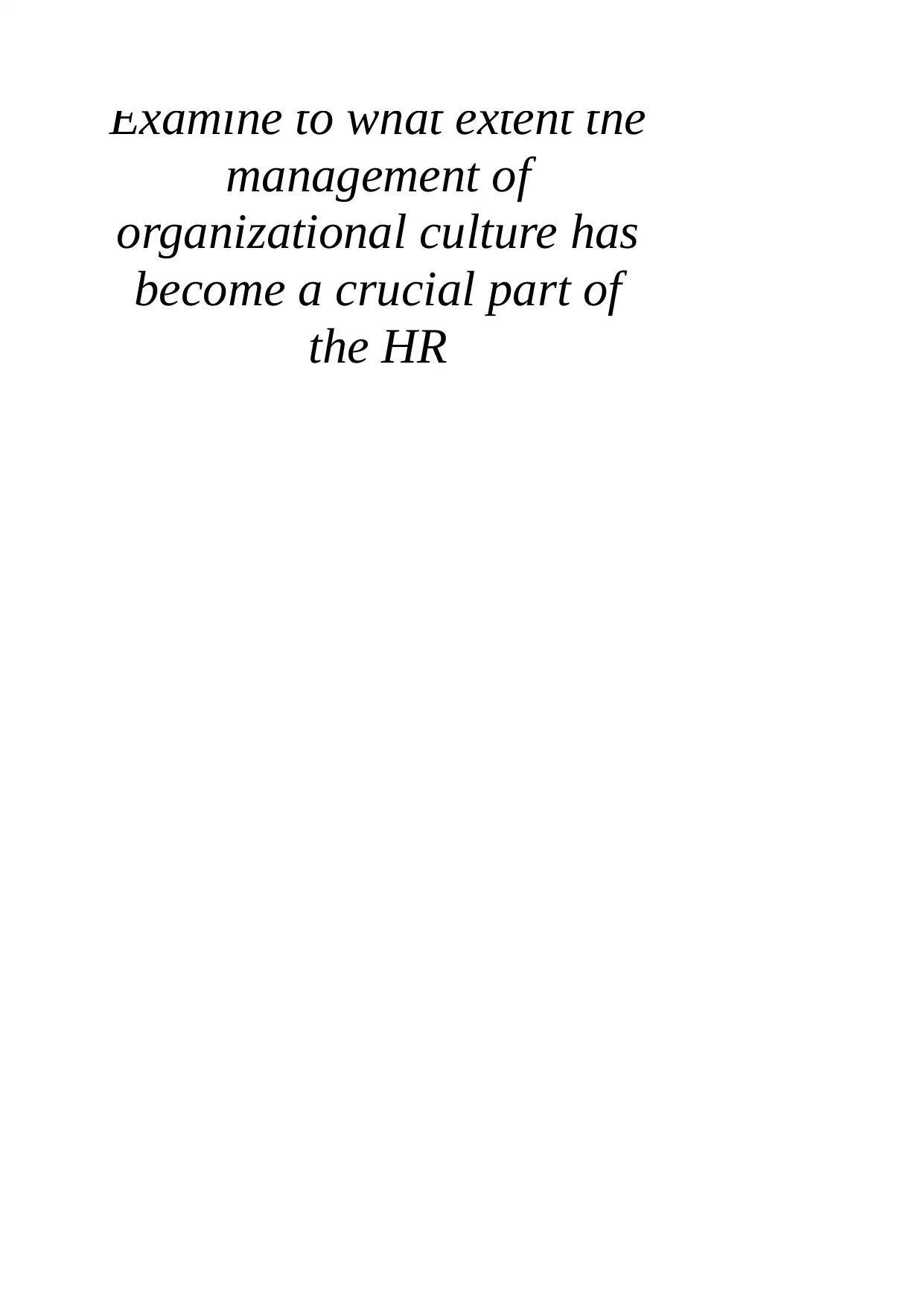
Examine to what extent the
management of
organizational culture has
become a crucial part of
the HR
management of
organizational culture has
become a crucial part of
the HR
Paraphrase This Document
Need a fresh take? Get an instant paraphrase of this document with our AI Paraphraser
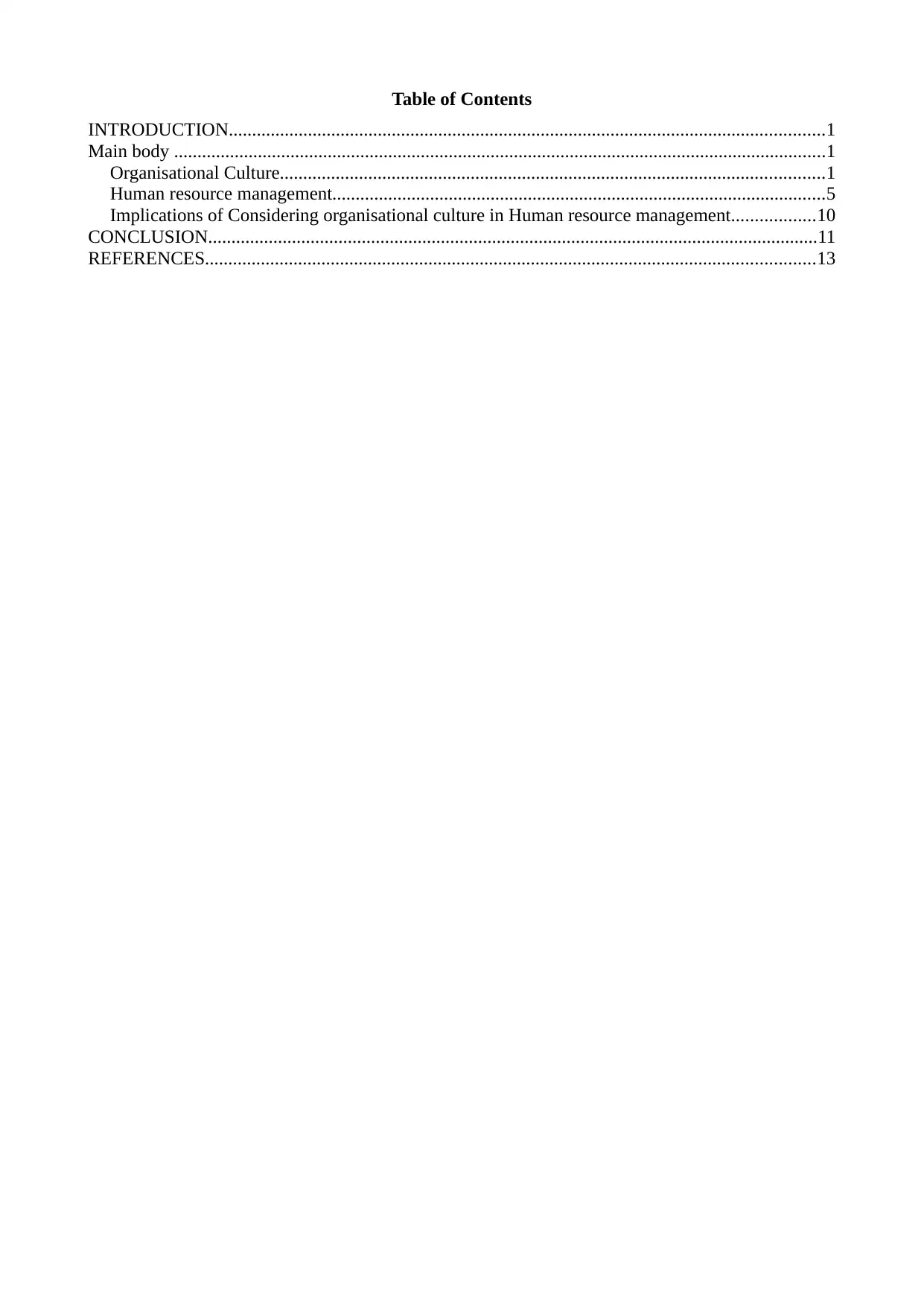
Table of Contents
INTRODUCTION................................................................................................................................1
Main body ............................................................................................................................................1
Organisational Culture.....................................................................................................................1
Human resource management..........................................................................................................5
Implications of Considering organisational culture in Human resource management..................10
CONCLUSION...................................................................................................................................11
REFERENCES...................................................................................................................................13
INTRODUCTION................................................................................................................................1
Main body ............................................................................................................................................1
Organisational Culture.....................................................................................................................1
Human resource management..........................................................................................................5
Implications of Considering organisational culture in Human resource management..................10
CONCLUSION...................................................................................................................................11
REFERENCES...................................................................................................................................13
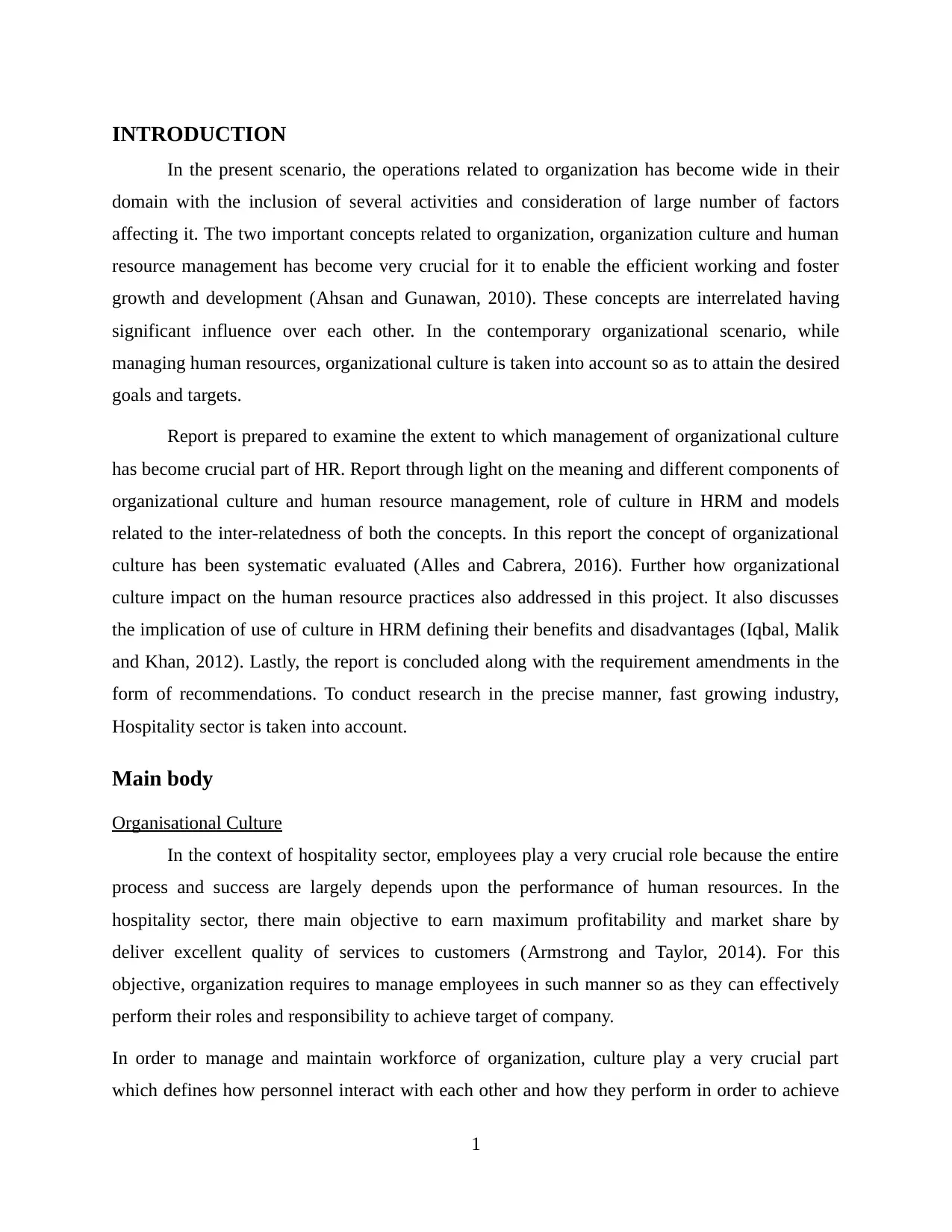
INTRODUCTION
In the present scenario, the operations related to organization has become wide in their
domain with the inclusion of several activities and consideration of large number of factors
affecting it. The two important concepts related to organization, organization culture and human
resource management has become very crucial for it to enable the efficient working and foster
growth and development (Ahsan and Gunawan, 2010). These concepts are interrelated having
significant influence over each other. In the contemporary organizational scenario, while
managing human resources, organizational culture is taken into account so as to attain the desired
goals and targets.
Report is prepared to examine the extent to which management of organizational culture
has become crucial part of HR. Report through light on the meaning and different components of
organizational culture and human resource management, role of culture in HRM and models
related to the inter-relatedness of both the concepts. In this report the concept of organizational
culture has been systematic evaluated (Alles and Cabrera, 2016). Further how organizational
culture impact on the human resource practices also addressed in this project. It also discusses
the implication of use of culture in HRM defining their benefits and disadvantages (Iqbal, Malik
and Khan, 2012). Lastly, the report is concluded along with the requirement amendments in the
form of recommendations. To conduct research in the precise manner, fast growing industry,
Hospitality sector is taken into account.
Main body
Organisational Culture
In the context of hospitality sector, employees play a very crucial role because the entire
process and success are largely depends upon the performance of human resources. In the
hospitality sector, there main objective to earn maximum profitability and market share by
deliver excellent quality of services to customers (Armstrong and Taylor, 2014). For this
objective, organization requires to manage employees in such manner so as they can effectively
perform their roles and responsibility to achieve target of company.
In order to manage and maintain workforce of organization, culture play a very crucial part
which defines how personnel interact with each other and how they perform in order to achieve
1
In the present scenario, the operations related to organization has become wide in their
domain with the inclusion of several activities and consideration of large number of factors
affecting it. The two important concepts related to organization, organization culture and human
resource management has become very crucial for it to enable the efficient working and foster
growth and development (Ahsan and Gunawan, 2010). These concepts are interrelated having
significant influence over each other. In the contemporary organizational scenario, while
managing human resources, organizational culture is taken into account so as to attain the desired
goals and targets.
Report is prepared to examine the extent to which management of organizational culture
has become crucial part of HR. Report through light on the meaning and different components of
organizational culture and human resource management, role of culture in HRM and models
related to the inter-relatedness of both the concepts. In this report the concept of organizational
culture has been systematic evaluated (Alles and Cabrera, 2016). Further how organizational
culture impact on the human resource practices also addressed in this project. It also discusses
the implication of use of culture in HRM defining their benefits and disadvantages (Iqbal, Malik
and Khan, 2012). Lastly, the report is concluded along with the requirement amendments in the
form of recommendations. To conduct research in the precise manner, fast growing industry,
Hospitality sector is taken into account.
Main body
Organisational Culture
In the context of hospitality sector, employees play a very crucial role because the entire
process and success are largely depends upon the performance of human resources. In the
hospitality sector, there main objective to earn maximum profitability and market share by
deliver excellent quality of services to customers (Armstrong and Taylor, 2014). For this
objective, organization requires to manage employees in such manner so as they can effectively
perform their roles and responsibility to achieve target of company.
In order to manage and maintain workforce of organization, culture play a very crucial part
which defines how personnel interact with each other and how they perform in order to achieve
1
⊘ This is a preview!⊘
Do you want full access?
Subscribe today to unlock all pages.

Trusted by 1+ million students worldwide
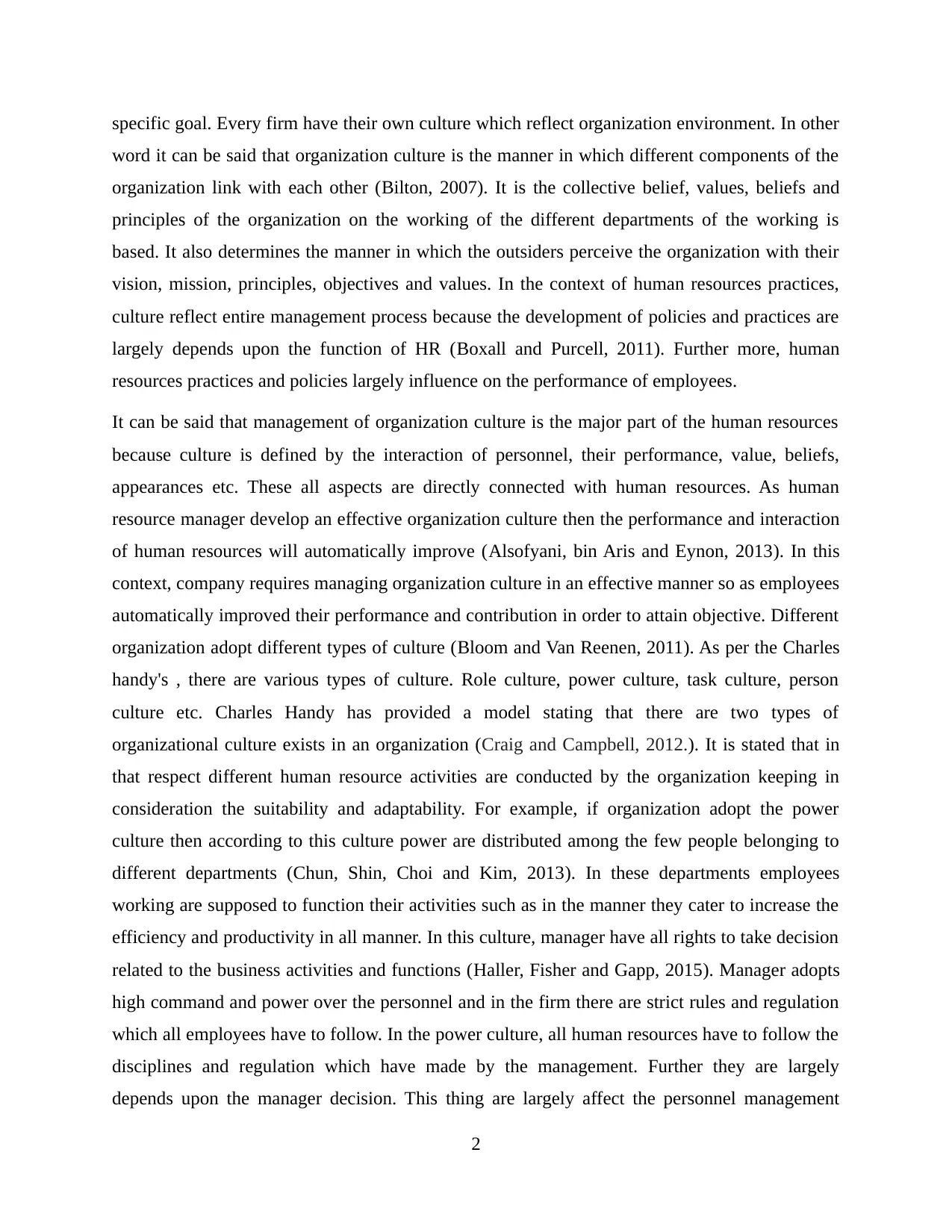
specific goal. Every firm have their own culture which reflect organization environment. In other
word it can be said that organization culture is the manner in which different components of the
organization link with each other (Bilton, 2007). It is the collective belief, values, beliefs and
principles of the organization on the working of the different departments of the working is
based. It also determines the manner in which the outsiders perceive the organization with their
vision, mission, principles, objectives and values. In the context of human resources practices,
culture reflect entire management process because the development of policies and practices are
largely depends upon the function of HR (Boxall and Purcell, 2011). Further more, human
resources practices and policies largely influence on the performance of employees.
It can be said that management of organization culture is the major part of the human resources
because culture is defined by the interaction of personnel, their performance, value, beliefs,
appearances etc. These all aspects are directly connected with human resources. As human
resource manager develop an effective organization culture then the performance and interaction
of human resources will automatically improve (Alsofyani, bin Aris and Eynon, 2013). In this
context, company requires managing organization culture in an effective manner so as employees
automatically improved their performance and contribution in order to attain objective. Different
organization adopt different types of culture (Bloom and Van Reenen, 2011). As per the Charles
handy's , there are various types of culture. Role culture, power culture, task culture, person
culture etc. Charles Handy has provided a model stating that there are two types of
organizational culture exists in an organization (Craig and Campbell, 2012.). It is stated that in
that respect different human resource activities are conducted by the organization keeping in
consideration the suitability and adaptability. For example, if organization adopt the power
culture then according to this culture power are distributed among the few people belonging to
different departments (Chun, Shin, Choi and Kim, 2013). In these departments employees
working are supposed to function their activities such as in the manner they cater to increase the
efficiency and productivity in all manner. In this culture, manager have all rights to take decision
related to the business activities and functions (Haller, Fisher and Gapp, 2015). Manager adopts
high command and power over the personnel and in the firm there are strict rules and regulation
which all employees have to follow. In the power culture, all human resources have to follow the
disciplines and regulation which have made by the management. Further they are largely
depends upon the manager decision. This thing are largely affect the personnel management
2
word it can be said that organization culture is the manner in which different components of the
organization link with each other (Bilton, 2007). It is the collective belief, values, beliefs and
principles of the organization on the working of the different departments of the working is
based. It also determines the manner in which the outsiders perceive the organization with their
vision, mission, principles, objectives and values. In the context of human resources practices,
culture reflect entire management process because the development of policies and practices are
largely depends upon the function of HR (Boxall and Purcell, 2011). Further more, human
resources practices and policies largely influence on the performance of employees.
It can be said that management of organization culture is the major part of the human resources
because culture is defined by the interaction of personnel, their performance, value, beliefs,
appearances etc. These all aspects are directly connected with human resources. As human
resource manager develop an effective organization culture then the performance and interaction
of human resources will automatically improve (Alsofyani, bin Aris and Eynon, 2013). In this
context, company requires managing organization culture in an effective manner so as employees
automatically improved their performance and contribution in order to attain objective. Different
organization adopt different types of culture (Bloom and Van Reenen, 2011). As per the Charles
handy's , there are various types of culture. Role culture, power culture, task culture, person
culture etc. Charles Handy has provided a model stating that there are two types of
organizational culture exists in an organization (Craig and Campbell, 2012.). It is stated that in
that respect different human resource activities are conducted by the organization keeping in
consideration the suitability and adaptability. For example, if organization adopt the power
culture then according to this culture power are distributed among the few people belonging to
different departments (Chun, Shin, Choi and Kim, 2013). In these departments employees
working are supposed to function their activities such as in the manner they cater to increase the
efficiency and productivity in all manner. In this culture, manager have all rights to take decision
related to the business activities and functions (Haller, Fisher and Gapp, 2015). Manager adopts
high command and power over the personnel and in the firm there are strict rules and regulation
which all employees have to follow. In the power culture, all human resources have to follow the
disciplines and regulation which have made by the management. Further they are largely
depends upon the manager decision. This thing are largely affect the personnel management
2
Paraphrase This Document
Need a fresh take? Get an instant paraphrase of this document with our AI Paraphraser
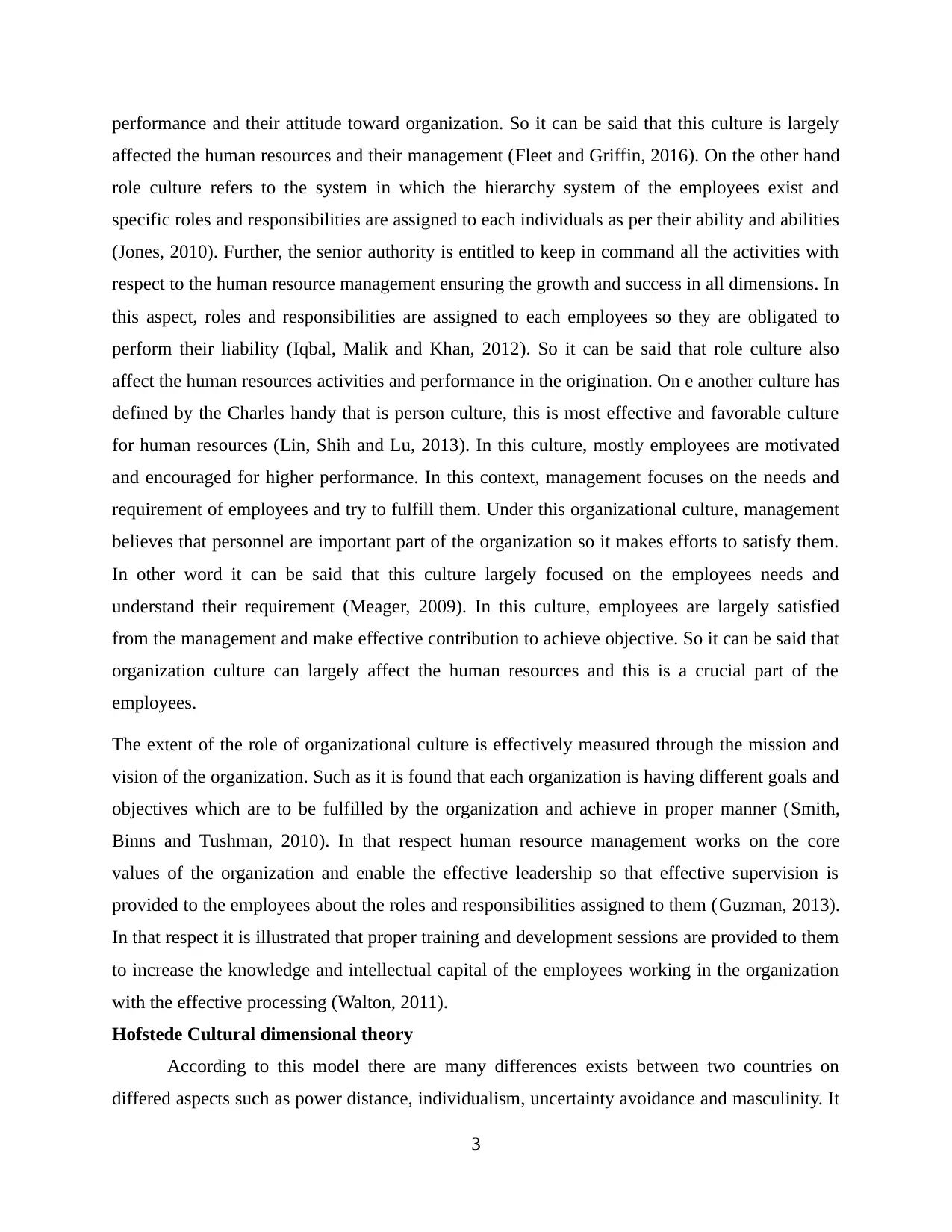
performance and their attitude toward organization. So it can be said that this culture is largely
affected the human resources and their management (Fleet and Griffin, 2016). On the other hand
role culture refers to the system in which the hierarchy system of the employees exist and
specific roles and responsibilities are assigned to each individuals as per their ability and abilities
(Jones, 2010). Further, the senior authority is entitled to keep in command all the activities with
respect to the human resource management ensuring the growth and success in all dimensions. In
this aspect, roles and responsibilities are assigned to each employees so they are obligated to
perform their liability (Iqbal, Malik and Khan, 2012). So it can be said that role culture also
affect the human resources activities and performance in the origination. On e another culture has
defined by the Charles handy that is person culture, this is most effective and favorable culture
for human resources (Lin, Shih and Lu, 2013). In this culture, mostly employees are motivated
and encouraged for higher performance. In this context, management focuses on the needs and
requirement of employees and try to fulfill them. Under this organizational culture, management
believes that personnel are important part of the organization so it makes efforts to satisfy them.
In other word it can be said that this culture largely focused on the employees needs and
understand their requirement (Meager, 2009). In this culture, employees are largely satisfied
from the management and make effective contribution to achieve objective. So it can be said that
organization culture can largely affect the human resources and this is a crucial part of the
employees.
The extent of the role of organizational culture is effectively measured through the mission and
vision of the organization. Such as it is found that each organization is having different goals and
objectives which are to be fulfilled by the organization and achieve in proper manner (Smith,
Binns and Tushman, 2010). In that respect human resource management works on the core
values of the organization and enable the effective leadership so that effective supervision is
provided to the employees about the roles and responsibilities assigned to them (Guzman, 2013).
In that respect it is illustrated that proper training and development sessions are provided to them
to increase the knowledge and intellectual capital of the employees working in the organization
with the effective processing (Walton, 2011).
Hofstede Cultural dimensional theory
According to this model there are many differences exists between two countries on
differed aspects such as power distance, individualism, uncertainty avoidance and masculinity. It
3
affected the human resources and their management (Fleet and Griffin, 2016). On the other hand
role culture refers to the system in which the hierarchy system of the employees exist and
specific roles and responsibilities are assigned to each individuals as per their ability and abilities
(Jones, 2010). Further, the senior authority is entitled to keep in command all the activities with
respect to the human resource management ensuring the growth and success in all dimensions. In
this aspect, roles and responsibilities are assigned to each employees so they are obligated to
perform their liability (Iqbal, Malik and Khan, 2012). So it can be said that role culture also
affect the human resources activities and performance in the origination. On e another culture has
defined by the Charles handy that is person culture, this is most effective and favorable culture
for human resources (Lin, Shih and Lu, 2013). In this culture, mostly employees are motivated
and encouraged for higher performance. In this context, management focuses on the needs and
requirement of employees and try to fulfill them. Under this organizational culture, management
believes that personnel are important part of the organization so it makes efforts to satisfy them.
In other word it can be said that this culture largely focused on the employees needs and
understand their requirement (Meager, 2009). In this culture, employees are largely satisfied
from the management and make effective contribution to achieve objective. So it can be said that
organization culture can largely affect the human resources and this is a crucial part of the
employees.
The extent of the role of organizational culture is effectively measured through the mission and
vision of the organization. Such as it is found that each organization is having different goals and
objectives which are to be fulfilled by the organization and achieve in proper manner (Smith,
Binns and Tushman, 2010). In that respect human resource management works on the core
values of the organization and enable the effective leadership so that effective supervision is
provided to the employees about the roles and responsibilities assigned to them (Guzman, 2013).
In that respect it is illustrated that proper training and development sessions are provided to them
to increase the knowledge and intellectual capital of the employees working in the organization
with the effective processing (Walton, 2011).
Hofstede Cultural dimensional theory
According to this model there are many differences exists between two countries on
differed aspects such as power distance, individualism, uncertainty avoidance and masculinity. It
3
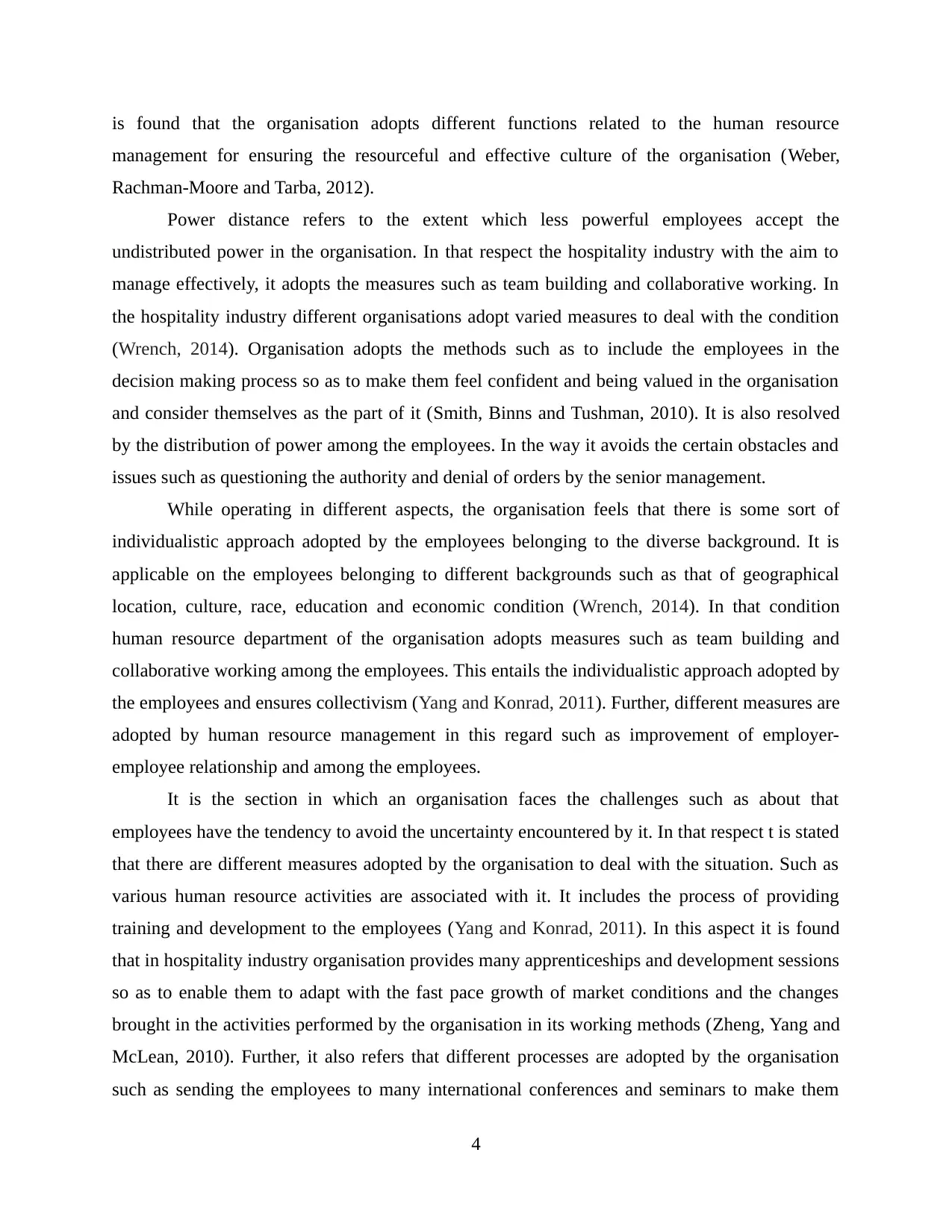
is found that the organisation adopts different functions related to the human resource
management for ensuring the resourceful and effective culture of the organisation (Weber,
Rachman-Moore and Tarba, 2012).
Power distance refers to the extent which less powerful employees accept the
undistributed power in the organisation. In that respect the hospitality industry with the aim to
manage effectively, it adopts the measures such as team building and collaborative working. In
the hospitality industry different organisations adopt varied measures to deal with the condition
(Wrench, 2014). Organisation adopts the methods such as to include the employees in the
decision making process so as to make them feel confident and being valued in the organisation
and consider themselves as the part of it (Smith, Binns and Tushman, 2010). It is also resolved
by the distribution of power among the employees. In the way it avoids the certain obstacles and
issues such as questioning the authority and denial of orders by the senior management.
While operating in different aspects, the organisation feels that there is some sort of
individualistic approach adopted by the employees belonging to the diverse background. It is
applicable on the employees belonging to different backgrounds such as that of geographical
location, culture, race, education and economic condition (Wrench, 2014). In that condition
human resource department of the organisation adopts measures such as team building and
collaborative working among the employees. This entails the individualistic approach adopted by
the employees and ensures collectivism (Yang and Konrad, 2011). Further, different measures are
adopted by human resource management in this regard such as improvement of employer-
employee relationship and among the employees.
It is the section in which an organisation faces the challenges such as about that
employees have the tendency to avoid the uncertainty encountered by it. In that respect t is stated
that there are different measures adopted by the organisation to deal with the situation. Such as
various human resource activities are associated with it. It includes the process of providing
training and development to the employees (Yang and Konrad, 2011). In this aspect it is found
that in hospitality industry organisation provides many apprenticeships and development sessions
so as to enable them to adapt with the fast pace growth of market conditions and the changes
brought in the activities performed by the organisation in its working methods (Zheng, Yang and
McLean, 2010). Further, it also refers that different processes are adopted by the organisation
such as sending the employees to many international conferences and seminars to make them
4
management for ensuring the resourceful and effective culture of the organisation (Weber,
Rachman-Moore and Tarba, 2012).
Power distance refers to the extent which less powerful employees accept the
undistributed power in the organisation. In that respect the hospitality industry with the aim to
manage effectively, it adopts the measures such as team building and collaborative working. In
the hospitality industry different organisations adopt varied measures to deal with the condition
(Wrench, 2014). Organisation adopts the methods such as to include the employees in the
decision making process so as to make them feel confident and being valued in the organisation
and consider themselves as the part of it (Smith, Binns and Tushman, 2010). It is also resolved
by the distribution of power among the employees. In the way it avoids the certain obstacles and
issues such as questioning the authority and denial of orders by the senior management.
While operating in different aspects, the organisation feels that there is some sort of
individualistic approach adopted by the employees belonging to the diverse background. It is
applicable on the employees belonging to different backgrounds such as that of geographical
location, culture, race, education and economic condition (Wrench, 2014). In that condition
human resource department of the organisation adopts measures such as team building and
collaborative working among the employees. This entails the individualistic approach adopted by
the employees and ensures collectivism (Yang and Konrad, 2011). Further, different measures are
adopted by human resource management in this regard such as improvement of employer-
employee relationship and among the employees.
It is the section in which an organisation faces the challenges such as about that
employees have the tendency to avoid the uncertainty encountered by it. In that respect t is stated
that there are different measures adopted by the organisation to deal with the situation. Such as
various human resource activities are associated with it. It includes the process of providing
training and development to the employees (Yang and Konrad, 2011). In this aspect it is found
that in hospitality industry organisation provides many apprenticeships and development sessions
so as to enable them to adapt with the fast pace growth of market conditions and the changes
brought in the activities performed by the organisation in its working methods (Zheng, Yang and
McLean, 2010). Further, it also refers that different processes are adopted by the organisation
such as sending the employees to many international conferences and seminars to make them
4
⊘ This is a preview!⊘
Do you want full access?
Subscribe today to unlock all pages.

Trusted by 1+ million students worldwide
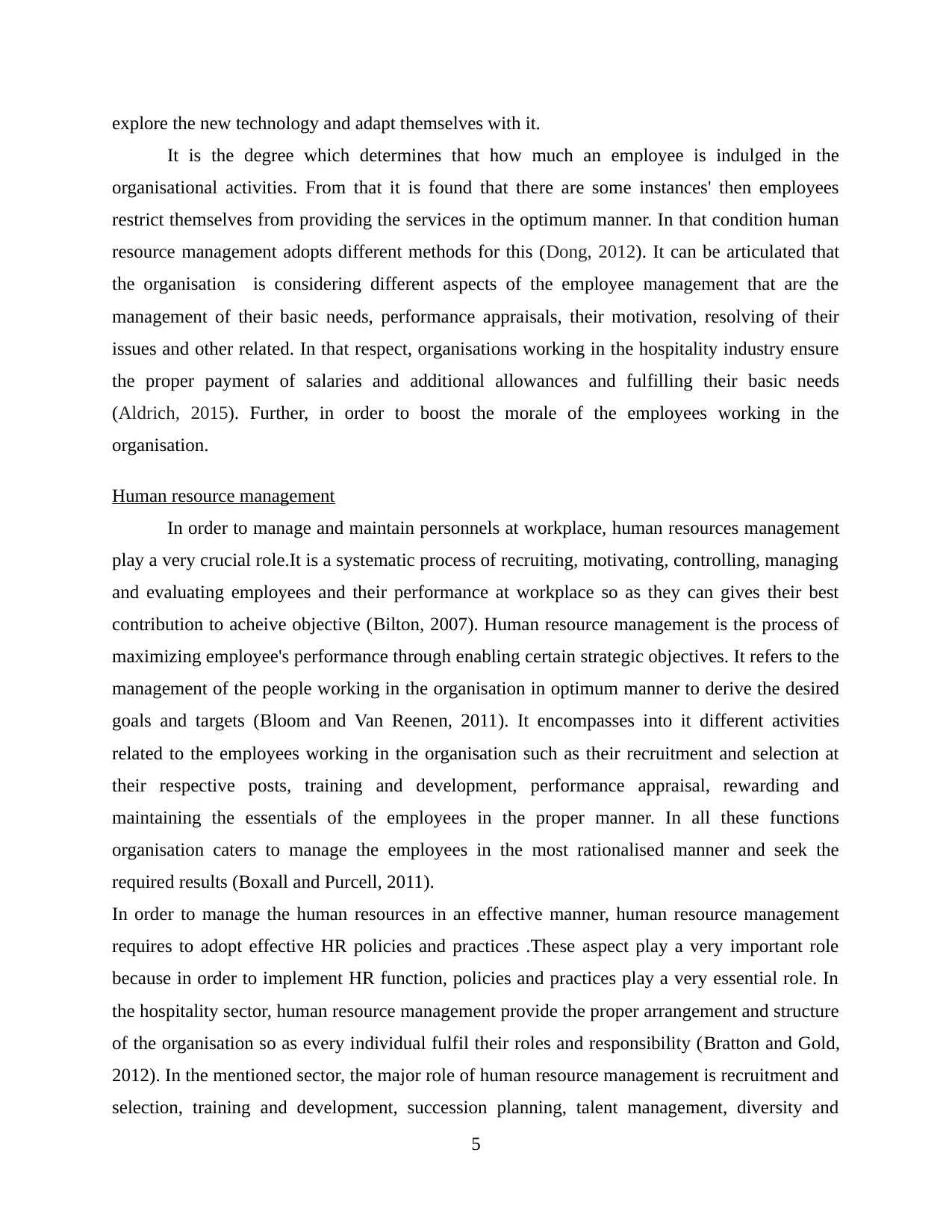
explore the new technology and adapt themselves with it.
It is the degree which determines that how much an employee is indulged in the
organisational activities. From that it is found that there are some instances' then employees
restrict themselves from providing the services in the optimum manner. In that condition human
resource management adopts different methods for this (Dong, 2012). It can be articulated that
the organisation is considering different aspects of the employee management that are the
management of their basic needs, performance appraisals, their motivation, resolving of their
issues and other related. In that respect, organisations working in the hospitality industry ensure
the proper payment of salaries and additional allowances and fulfilling their basic needs
(Aldrich, 2015). Further, in order to boost the morale of the employees working in the
organisation.
Human resource management
In order to manage and maintain personnels at workplace, human resources management
play a very crucial role.It is a systematic process of recruiting, motivating, controlling, managing
and evaluating employees and their performance at workplace so as they can gives their best
contribution to acheive objective (Bilton, 2007). Human resource management is the process of
maximizing employee's performance through enabling certain strategic objectives. It refers to the
management of the people working in the organisation in optimum manner to derive the desired
goals and targets (Bloom and Van Reenen, 2011). It encompasses into it different activities
related to the employees working in the organisation such as their recruitment and selection at
their respective posts, training and development, performance appraisal, rewarding and
maintaining the essentials of the employees in the proper manner. In all these functions
organisation caters to manage the employees in the most rationalised manner and seek the
required results (Boxall and Purcell, 2011).
In order to manage the human resources in an effective manner, human resource management
requires to adopt effective HR policies and practices .These aspect play a very important role
because in order to implement HR function, policies and practices play a very essential role. In
the hospitality sector, human resource management provide the proper arrangement and structure
of the organisation so as every individual fulfil their roles and responsibility (Bratton and Gold,
2012). In the mentioned sector, the major role of human resource management is recruitment and
selection, training and development, succession planning, talent management, diversity and
5
It is the degree which determines that how much an employee is indulged in the
organisational activities. From that it is found that there are some instances' then employees
restrict themselves from providing the services in the optimum manner. In that condition human
resource management adopts different methods for this (Dong, 2012). It can be articulated that
the organisation is considering different aspects of the employee management that are the
management of their basic needs, performance appraisals, their motivation, resolving of their
issues and other related. In that respect, organisations working in the hospitality industry ensure
the proper payment of salaries and additional allowances and fulfilling their basic needs
(Aldrich, 2015). Further, in order to boost the morale of the employees working in the
organisation.
Human resource management
In order to manage and maintain personnels at workplace, human resources management
play a very crucial role.It is a systematic process of recruiting, motivating, controlling, managing
and evaluating employees and their performance at workplace so as they can gives their best
contribution to acheive objective (Bilton, 2007). Human resource management is the process of
maximizing employee's performance through enabling certain strategic objectives. It refers to the
management of the people working in the organisation in optimum manner to derive the desired
goals and targets (Bloom and Van Reenen, 2011). It encompasses into it different activities
related to the employees working in the organisation such as their recruitment and selection at
their respective posts, training and development, performance appraisal, rewarding and
maintaining the essentials of the employees in the proper manner. In all these functions
organisation caters to manage the employees in the most rationalised manner and seek the
required results (Boxall and Purcell, 2011).
In order to manage the human resources in an effective manner, human resource management
requires to adopt effective HR policies and practices .These aspect play a very important role
because in order to implement HR function, policies and practices play a very essential role. In
the hospitality sector, human resource management provide the proper arrangement and structure
of the organisation so as every individual fulfil their roles and responsibility (Bratton and Gold,
2012). In the mentioned sector, the major role of human resource management is recruitment and
selection, training and development, succession planning, talent management, diversity and
5
Paraphrase This Document
Need a fresh take? Get an instant paraphrase of this document with our AI Paraphraser
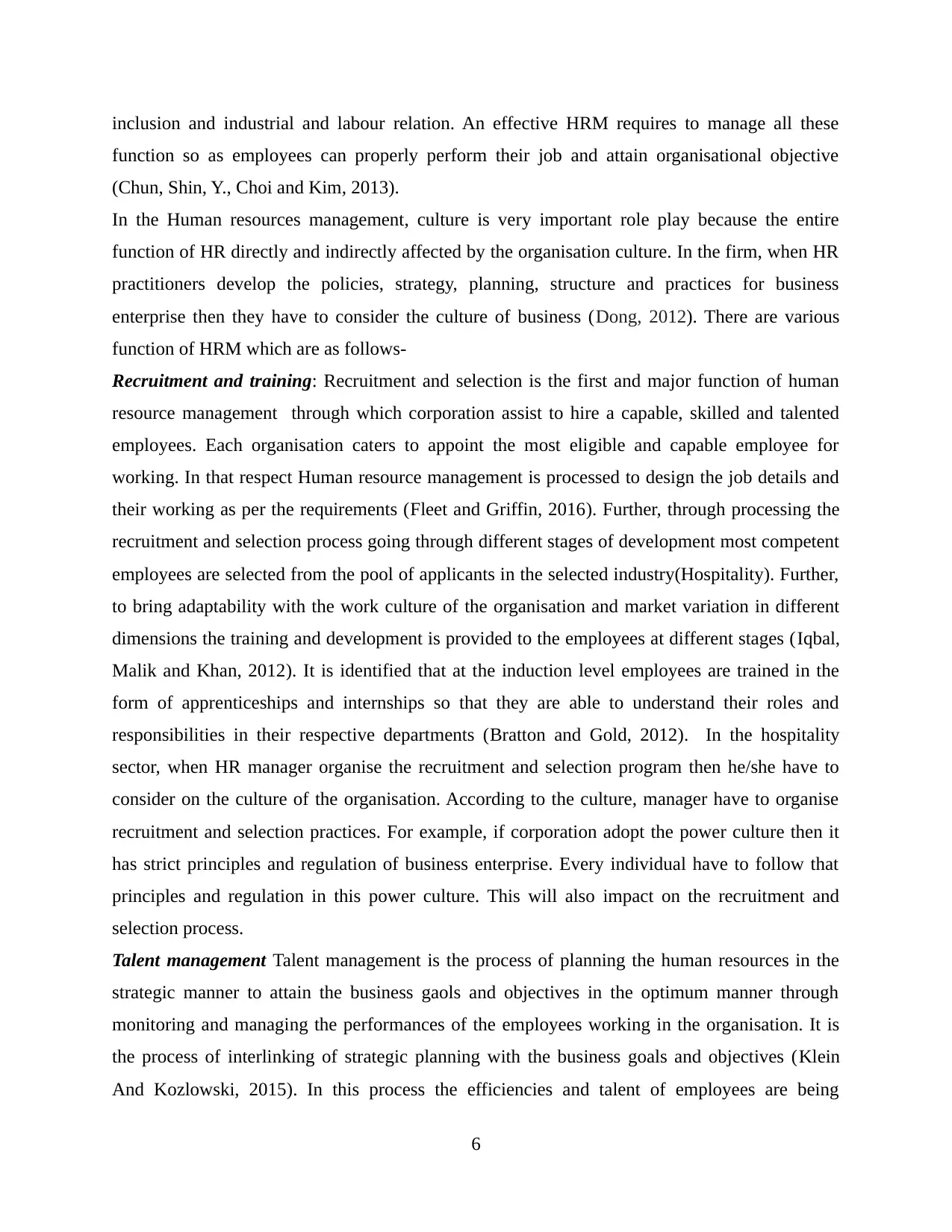
inclusion and industrial and labour relation. An effective HRM requires to manage all these
function so as employees can properly perform their job and attain organisational objective
(Chun, Shin, Y., Choi and Kim, 2013).
In the Human resources management, culture is very important role play because the entire
function of HR directly and indirectly affected by the organisation culture. In the firm, when HR
practitioners develop the policies, strategy, planning, structure and practices for business
enterprise then they have to consider the culture of business (Dong, 2012). There are various
function of HRM which are as follows-
Recruitment and training: Recruitment and selection is the first and major function of human
resource management through which corporation assist to hire a capable, skilled and talented
employees. Each organisation caters to appoint the most eligible and capable employee for
working. In that respect Human resource management is processed to design the job details and
their working as per the requirements (Fleet and Griffin, 2016). Further, through processing the
recruitment and selection process going through different stages of development most competent
employees are selected from the pool of applicants in the selected industry(Hospitality). Further,
to bring adaptability with the work culture of the organisation and market variation in different
dimensions the training and development is provided to the employees at different stages (Iqbal,
Malik and Khan, 2012). It is identified that at the induction level employees are trained in the
form of apprenticeships and internships so that they are able to understand their roles and
responsibilities in their respective departments (Bratton and Gold, 2012). In the hospitality
sector, when HR manager organise the recruitment and selection program then he/she have to
consider on the culture of the organisation. According to the culture, manager have to organise
recruitment and selection practices. For example, if corporation adopt the power culture then it
has strict principles and regulation of business enterprise. Every individual have to follow that
principles and regulation in this power culture. This will also impact on the recruitment and
selection process.
Talent management Talent management is the process of planning the human resources in the
strategic manner to attain the business gaols and objectives in the optimum manner through
monitoring and managing the performances of the employees working in the organisation. It is
the process of interlinking of strategic planning with the business goals and objectives (Klein
And Kozlowski, 2015). In this process the efficiencies and talent of employees are being
6
function so as employees can properly perform their job and attain organisational objective
(Chun, Shin, Y., Choi and Kim, 2013).
In the Human resources management, culture is very important role play because the entire
function of HR directly and indirectly affected by the organisation culture. In the firm, when HR
practitioners develop the policies, strategy, planning, structure and practices for business
enterprise then they have to consider the culture of business (Dong, 2012). There are various
function of HRM which are as follows-
Recruitment and training: Recruitment and selection is the first and major function of human
resource management through which corporation assist to hire a capable, skilled and talented
employees. Each organisation caters to appoint the most eligible and capable employee for
working. In that respect Human resource management is processed to design the job details and
their working as per the requirements (Fleet and Griffin, 2016). Further, through processing the
recruitment and selection process going through different stages of development most competent
employees are selected from the pool of applicants in the selected industry(Hospitality). Further,
to bring adaptability with the work culture of the organisation and market variation in different
dimensions the training and development is provided to the employees at different stages (Iqbal,
Malik and Khan, 2012). It is identified that at the induction level employees are trained in the
form of apprenticeships and internships so that they are able to understand their roles and
responsibilities in their respective departments (Bratton and Gold, 2012). In the hospitality
sector, when HR manager organise the recruitment and selection program then he/she have to
consider on the culture of the organisation. According to the culture, manager have to organise
recruitment and selection practices. For example, if corporation adopt the power culture then it
has strict principles and regulation of business enterprise. Every individual have to follow that
principles and regulation in this power culture. This will also impact on the recruitment and
selection process.
Talent management Talent management is the process of planning the human resources in the
strategic manner to attain the business gaols and objectives in the optimum manner through
monitoring and managing the performances of the employees working in the organisation. It is
the process of interlinking of strategic planning with the business goals and objectives (Klein
And Kozlowski, 2015). In this process the efficiencies and talent of employees are being
6
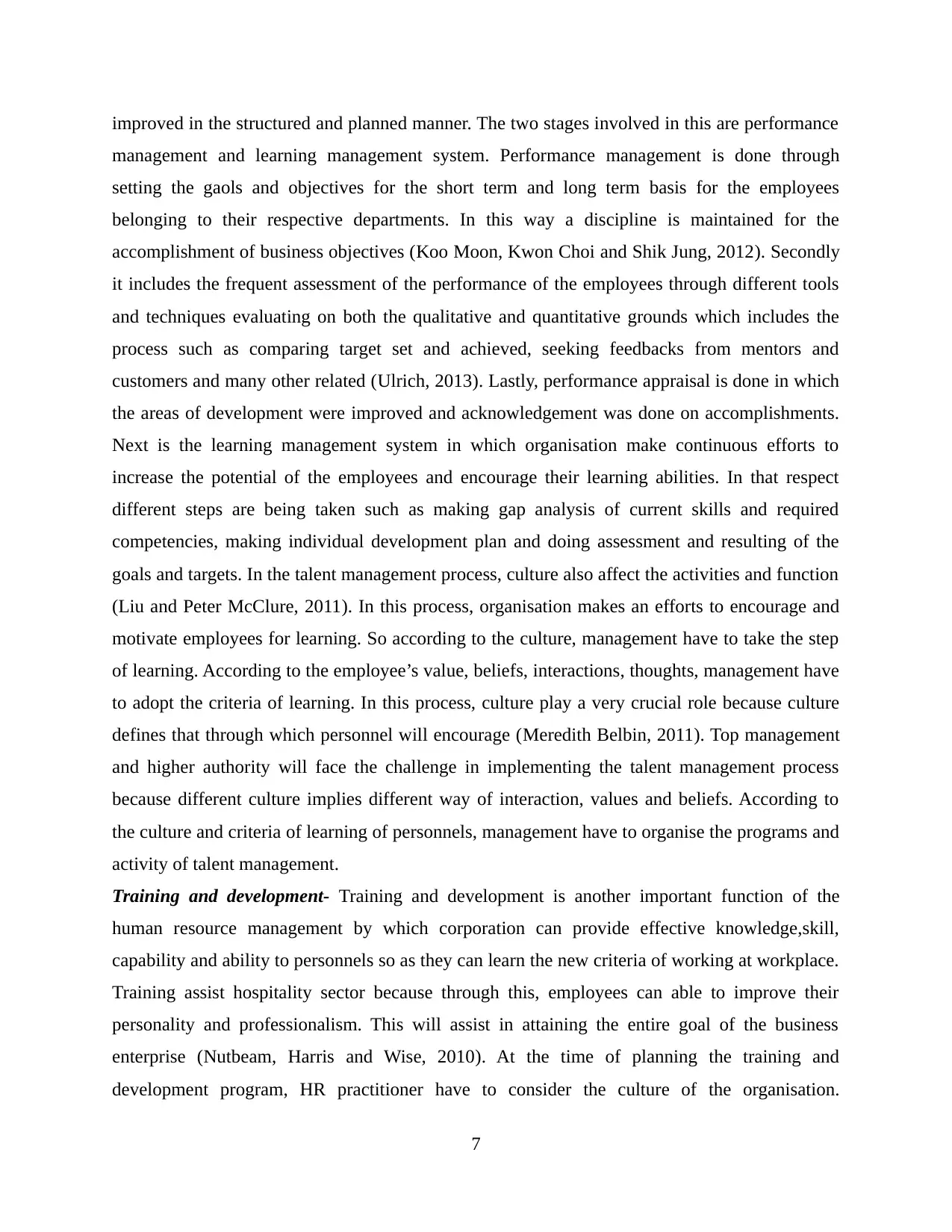
improved in the structured and planned manner. The two stages involved in this are performance
management and learning management system. Performance management is done through
setting the gaols and objectives for the short term and long term basis for the employees
belonging to their respective departments. In this way a discipline is maintained for the
accomplishment of business objectives (Koo Moon, Kwon Choi and Shik Jung, 2012). Secondly
it includes the frequent assessment of the performance of the employees through different tools
and techniques evaluating on both the qualitative and quantitative grounds which includes the
process such as comparing target set and achieved, seeking feedbacks from mentors and
customers and many other related (Ulrich, 2013). Lastly, performance appraisal is done in which
the areas of development were improved and acknowledgement was done on accomplishments.
Next is the learning management system in which organisation make continuous efforts to
increase the potential of the employees and encourage their learning abilities. In that respect
different steps are being taken such as making gap analysis of current skills and required
competencies, making individual development plan and doing assessment and resulting of the
goals and targets. In the talent management process, culture also affect the activities and function
(Liu and Peter McClure, 2011). In this process, organisation makes an efforts to encourage and
motivate employees for learning. So according to the culture, management have to take the step
of learning. According to the employee’s value, beliefs, interactions, thoughts, management have
to adopt the criteria of learning. In this process, culture play a very crucial role because culture
defines that through which personnel will encourage (Meredith Belbin, 2011). Top management
and higher authority will face the challenge in implementing the talent management process
because different culture implies different way of interaction, values and beliefs. According to
the culture and criteria of learning of personnels, management have to organise the programs and
activity of talent management.
Training and development- Training and development is another important function of the
human resource management by which corporation can provide effective knowledge,skill,
capability and ability to personnels so as they can learn the new criteria of working at workplace.
Training assist hospitality sector because through this, employees can able to improve their
personality and professionalism. This will assist in attaining the entire goal of the business
enterprise (Nutbeam, Harris and Wise, 2010). At the time of planning the training and
development program, HR practitioner have to consider the culture of the organisation.
7
management and learning management system. Performance management is done through
setting the gaols and objectives for the short term and long term basis for the employees
belonging to their respective departments. In this way a discipline is maintained for the
accomplishment of business objectives (Koo Moon, Kwon Choi and Shik Jung, 2012). Secondly
it includes the frequent assessment of the performance of the employees through different tools
and techniques evaluating on both the qualitative and quantitative grounds which includes the
process such as comparing target set and achieved, seeking feedbacks from mentors and
customers and many other related (Ulrich, 2013). Lastly, performance appraisal is done in which
the areas of development were improved and acknowledgement was done on accomplishments.
Next is the learning management system in which organisation make continuous efforts to
increase the potential of the employees and encourage their learning abilities. In that respect
different steps are being taken such as making gap analysis of current skills and required
competencies, making individual development plan and doing assessment and resulting of the
goals and targets. In the talent management process, culture also affect the activities and function
(Liu and Peter McClure, 2011). In this process, organisation makes an efforts to encourage and
motivate employees for learning. So according to the culture, management have to take the step
of learning. According to the employee’s value, beliefs, interactions, thoughts, management have
to adopt the criteria of learning. In this process, culture play a very crucial role because culture
defines that through which personnel will encourage (Meredith Belbin, 2011). Top management
and higher authority will face the challenge in implementing the talent management process
because different culture implies different way of interaction, values and beliefs. According to
the culture and criteria of learning of personnels, management have to organise the programs and
activity of talent management.
Training and development- Training and development is another important function of the
human resource management by which corporation can provide effective knowledge,skill,
capability and ability to personnels so as they can learn the new criteria of working at workplace.
Training assist hospitality sector because through this, employees can able to improve their
personality and professionalism. This will assist in attaining the entire goal of the business
enterprise (Nutbeam, Harris and Wise, 2010). At the time of planning the training and
development program, HR practitioner have to consider the culture of the organisation.
7
⊘ This is a preview!⊘
Do you want full access?
Subscribe today to unlock all pages.

Trusted by 1+ million students worldwide
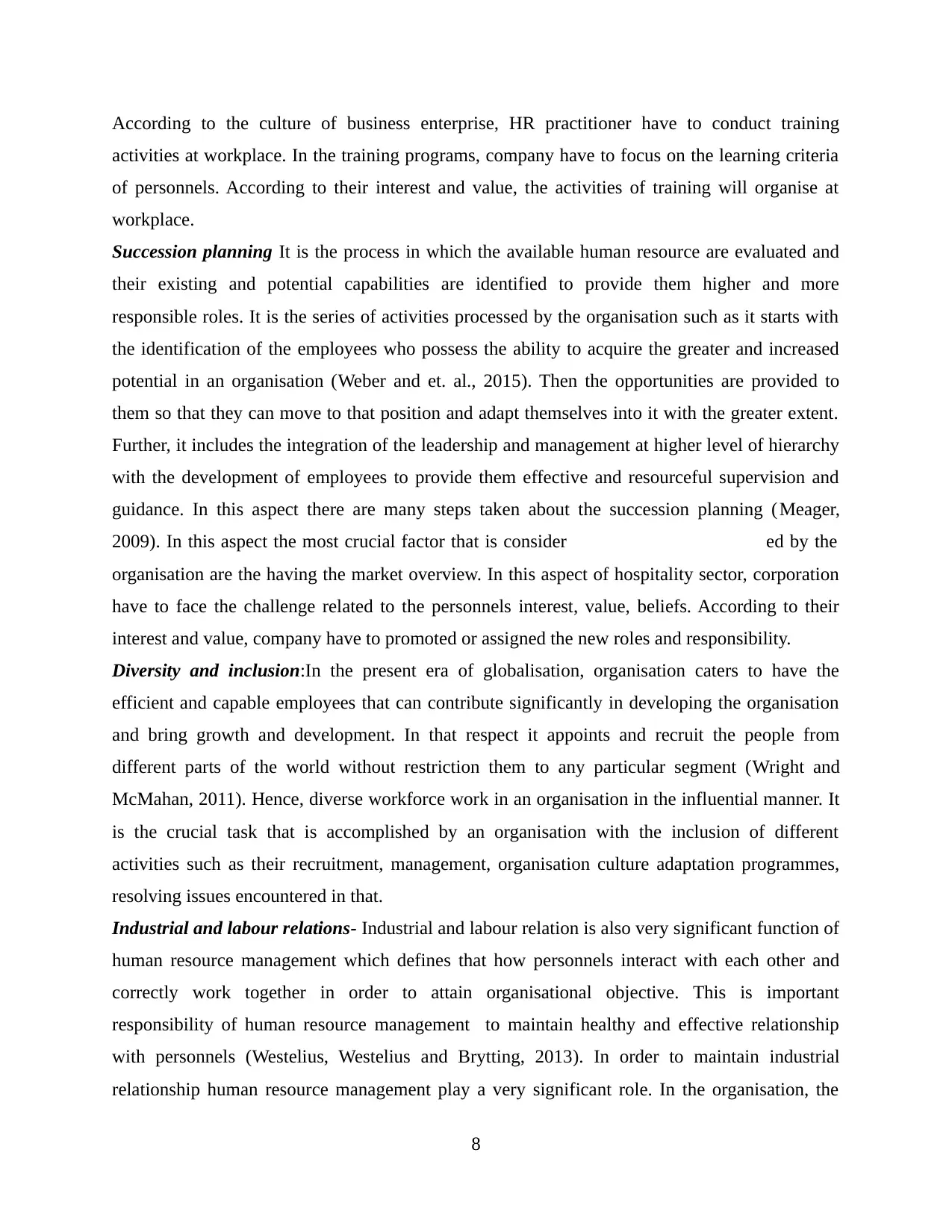
According to the culture of business enterprise, HR practitioner have to conduct training
activities at workplace. In the training programs, company have to focus on the learning criteria
of personnels. According to their interest and value, the activities of training will organise at
workplace.
Succession planning It is the process in which the available human resource are evaluated and
their existing and potential capabilities are identified to provide them higher and more
responsible roles. It is the series of activities processed by the organisation such as it starts with
the identification of the employees who possess the ability to acquire the greater and increased
potential in an organisation (Weber and et. al., 2015). Then the opportunities are provided to
them so that they can move to that position and adapt themselves into it with the greater extent.
Further, it includes the integration of the leadership and management at higher level of hierarchy
with the development of employees to provide them effective and resourceful supervision and
guidance. In this aspect there are many steps taken about the succession planning (Meager,
2009). In this aspect the most crucial factor that is consider ed by the
organisation are the having the market overview. In this aspect of hospitality sector, corporation
have to face the challenge related to the personnels interest, value, beliefs. According to their
interest and value, company have to promoted or assigned the new roles and responsibility.
Diversity and inclusion:In the present era of globalisation, organisation caters to have the
efficient and capable employees that can contribute significantly in developing the organisation
and bring growth and development. In that respect it appoints and recruit the people from
different parts of the world without restriction them to any particular segment (Wright and
McMahan, 2011). Hence, diverse workforce work in an organisation in the influential manner. It
is the crucial task that is accomplished by an organisation with the inclusion of different
activities such as their recruitment, management, organisation culture adaptation programmes,
resolving issues encountered in that.
Industrial and labour relations- Industrial and labour relation is also very significant function of
human resource management which defines that how personnels interact with each other and
correctly work together in order to attain organisational objective. This is important
responsibility of human resource management to maintain healthy and effective relationship
with personnels (Westelius, Westelius and Brytting, 2013). In order to maintain industrial
relationship human resource management play a very significant role. In the organisation, the
8
activities at workplace. In the training programs, company have to focus on the learning criteria
of personnels. According to their interest and value, the activities of training will organise at
workplace.
Succession planning It is the process in which the available human resource are evaluated and
their existing and potential capabilities are identified to provide them higher and more
responsible roles. It is the series of activities processed by the organisation such as it starts with
the identification of the employees who possess the ability to acquire the greater and increased
potential in an organisation (Weber and et. al., 2015). Then the opportunities are provided to
them so that they can move to that position and adapt themselves into it with the greater extent.
Further, it includes the integration of the leadership and management at higher level of hierarchy
with the development of employees to provide them effective and resourceful supervision and
guidance. In this aspect there are many steps taken about the succession planning (Meager,
2009). In this aspect the most crucial factor that is consider ed by the
organisation are the having the market overview. In this aspect of hospitality sector, corporation
have to face the challenge related to the personnels interest, value, beliefs. According to their
interest and value, company have to promoted or assigned the new roles and responsibility.
Diversity and inclusion:In the present era of globalisation, organisation caters to have the
efficient and capable employees that can contribute significantly in developing the organisation
and bring growth and development. In that respect it appoints and recruit the people from
different parts of the world without restriction them to any particular segment (Wright and
McMahan, 2011). Hence, diverse workforce work in an organisation in the influential manner. It
is the crucial task that is accomplished by an organisation with the inclusion of different
activities such as their recruitment, management, organisation culture adaptation programmes,
resolving issues encountered in that.
Industrial and labour relations- Industrial and labour relation is also very significant function of
human resource management which defines that how personnels interact with each other and
correctly work together in order to attain organisational objective. This is important
responsibility of human resource management to maintain healthy and effective relationship
with personnels (Westelius, Westelius and Brytting, 2013). In order to maintain industrial
relationship human resource management play a very significant role. In the organisation, the
8
Paraphrase This Document
Need a fresh take? Get an instant paraphrase of this document with our AI Paraphraser
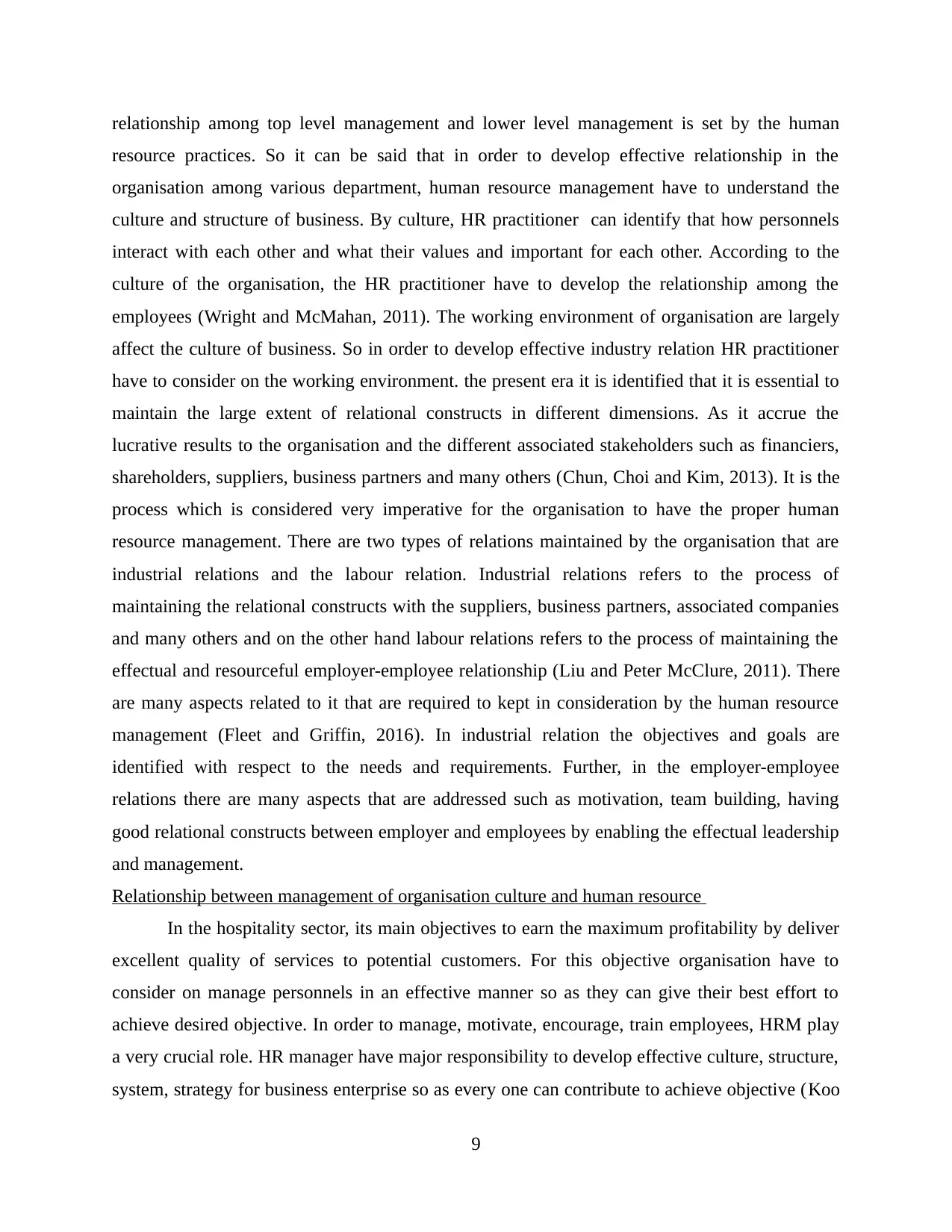
relationship among top level management and lower level management is set by the human
resource practices. So it can be said that in order to develop effective relationship in the
organisation among various department, human resource management have to understand the
culture and structure of business. By culture, HR practitioner can identify that how personnels
interact with each other and what their values and important for each other. According to the
culture of the organisation, the HR practitioner have to develop the relationship among the
employees (Wright and McMahan, 2011). The working environment of organisation are largely
affect the culture of business. So in order to develop effective industry relation HR practitioner
have to consider on the working environment. the present era it is identified that it is essential to
maintain the large extent of relational constructs in different dimensions. As it accrue the
lucrative results to the organisation and the different associated stakeholders such as financiers,
shareholders, suppliers, business partners and many others (Chun, Choi and Kim, 2013). It is the
process which is considered very imperative for the organisation to have the proper human
resource management. There are two types of relations maintained by the organisation that are
industrial relations and the labour relation. Industrial relations refers to the process of
maintaining the relational constructs with the suppliers, business partners, associated companies
and many others and on the other hand labour relations refers to the process of maintaining the
effectual and resourceful employer-employee relationship (Liu and Peter McClure, 2011). There
are many aspects related to it that are required to kept in consideration by the human resource
management (Fleet and Griffin, 2016). In industrial relation the objectives and goals are
identified with respect to the needs and requirements. Further, in the employer-employee
relations there are many aspects that are addressed such as motivation, team building, having
good relational constructs between employer and employees by enabling the effectual leadership
and management.
Relationship between management of organisation culture and human resource
In the hospitality sector, its main objectives to earn the maximum profitability by deliver
excellent quality of services to potential customers. For this objective organisation have to
consider on manage personnels in an effective manner so as they can give their best effort to
achieve desired objective. In order to manage, motivate, encourage, train employees, HRM play
a very crucial role. HR manager have major responsibility to develop effective culture, structure,
system, strategy for business enterprise so as every one can contribute to achieve objective (Koo
9
resource practices. So it can be said that in order to develop effective relationship in the
organisation among various department, human resource management have to understand the
culture and structure of business. By culture, HR practitioner can identify that how personnels
interact with each other and what their values and important for each other. According to the
culture of the organisation, the HR practitioner have to develop the relationship among the
employees (Wright and McMahan, 2011). The working environment of organisation are largely
affect the culture of business. So in order to develop effective industry relation HR practitioner
have to consider on the working environment. the present era it is identified that it is essential to
maintain the large extent of relational constructs in different dimensions. As it accrue the
lucrative results to the organisation and the different associated stakeholders such as financiers,
shareholders, suppliers, business partners and many others (Chun, Choi and Kim, 2013). It is the
process which is considered very imperative for the organisation to have the proper human
resource management. There are two types of relations maintained by the organisation that are
industrial relations and the labour relation. Industrial relations refers to the process of
maintaining the relational constructs with the suppliers, business partners, associated companies
and many others and on the other hand labour relations refers to the process of maintaining the
effectual and resourceful employer-employee relationship (Liu and Peter McClure, 2011). There
are many aspects related to it that are required to kept in consideration by the human resource
management (Fleet and Griffin, 2016). In industrial relation the objectives and goals are
identified with respect to the needs and requirements. Further, in the employer-employee
relations there are many aspects that are addressed such as motivation, team building, having
good relational constructs between employer and employees by enabling the effectual leadership
and management.
Relationship between management of organisation culture and human resource
In the hospitality sector, its main objectives to earn the maximum profitability by deliver
excellent quality of services to potential customers. For this objective organisation have to
consider on manage personnels in an effective manner so as they can give their best effort to
achieve desired objective. In order to manage, motivate, encourage, train employees, HRM play
a very crucial role. HR manager have major responsibility to develop effective culture, structure,
system, strategy for business enterprise so as every one can contribute to achieve objective (Koo
9
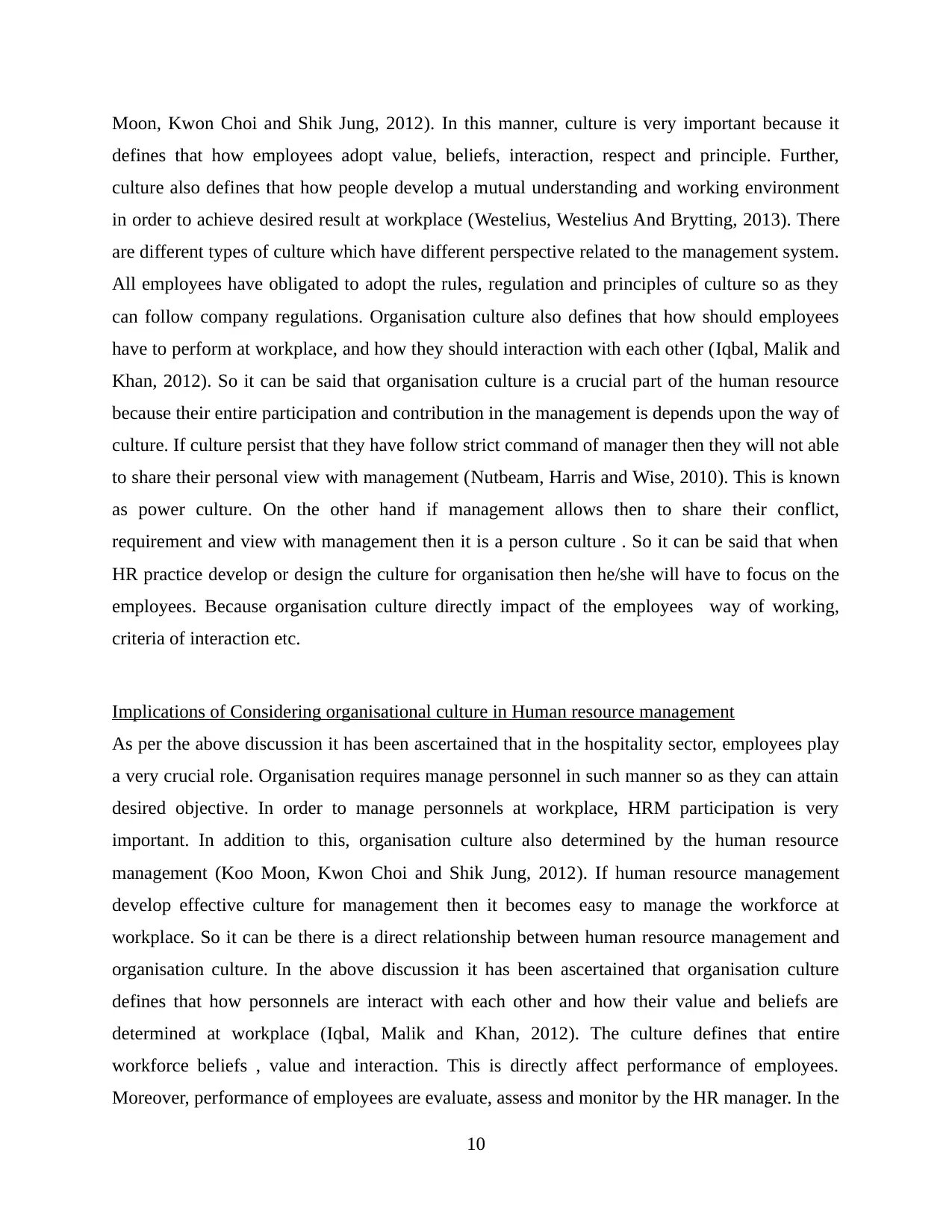
Moon, Kwon Choi and Shik Jung, 2012). In this manner, culture is very important because it
defines that how employees adopt value, beliefs, interaction, respect and principle. Further,
culture also defines that how people develop a mutual understanding and working environment
in order to achieve desired result at workplace (Westelius, Westelius And Brytting, 2013). There
are different types of culture which have different perspective related to the management system.
All employees have obligated to adopt the rules, regulation and principles of culture so as they
can follow company regulations. Organisation culture also defines that how should employees
have to perform at workplace, and how they should interaction with each other (Iqbal, Malik and
Khan, 2012). So it can be said that organisation culture is a crucial part of the human resource
because their entire participation and contribution in the management is depends upon the way of
culture. If culture persist that they have follow strict command of manager then they will not able
to share their personal view with management (Nutbeam, Harris and Wise, 2010). This is known
as power culture. On the other hand if management allows then to share their conflict,
requirement and view with management then it is a person culture . So it can be said that when
HR practice develop or design the culture for organisation then he/she will have to focus on the
employees. Because organisation culture directly impact of the employees way of working,
criteria of interaction etc.
Implications of Considering organisational culture in Human resource management
As per the above discussion it has been ascertained that in the hospitality sector, employees play
a very crucial role. Organisation requires manage personnel in such manner so as they can attain
desired objective. In order to manage personnels at workplace, HRM participation is very
important. In addition to this, organisation culture also determined by the human resource
management (Koo Moon, Kwon Choi and Shik Jung, 2012). If human resource management
develop effective culture for management then it becomes easy to manage the workforce at
workplace. So it can be there is a direct relationship between human resource management and
organisation culture. In the above discussion it has been ascertained that organisation culture
defines that how personnels are interact with each other and how their value and beliefs are
determined at workplace (Iqbal, Malik and Khan, 2012). The culture defines that entire
workforce beliefs , value and interaction. This is directly affect performance of employees.
Moreover, performance of employees are evaluate, assess and monitor by the HR manager. In the
10
defines that how employees adopt value, beliefs, interaction, respect and principle. Further,
culture also defines that how people develop a mutual understanding and working environment
in order to achieve desired result at workplace (Westelius, Westelius And Brytting, 2013). There
are different types of culture which have different perspective related to the management system.
All employees have obligated to adopt the rules, regulation and principles of culture so as they
can follow company regulations. Organisation culture also defines that how should employees
have to perform at workplace, and how they should interaction with each other (Iqbal, Malik and
Khan, 2012). So it can be said that organisation culture is a crucial part of the human resource
because their entire participation and contribution in the management is depends upon the way of
culture. If culture persist that they have follow strict command of manager then they will not able
to share their personal view with management (Nutbeam, Harris and Wise, 2010). This is known
as power culture. On the other hand if management allows then to share their conflict,
requirement and view with management then it is a person culture . So it can be said that when
HR practice develop or design the culture for organisation then he/she will have to focus on the
employees. Because organisation culture directly impact of the employees way of working,
criteria of interaction etc.
Implications of Considering organisational culture in Human resource management
As per the above discussion it has been ascertained that in the hospitality sector, employees play
a very crucial role. Organisation requires manage personnel in such manner so as they can attain
desired objective. In order to manage personnels at workplace, HRM participation is very
important. In addition to this, organisation culture also determined by the human resource
management (Koo Moon, Kwon Choi and Shik Jung, 2012). If human resource management
develop effective culture for management then it becomes easy to manage the workforce at
workplace. So it can be there is a direct relationship between human resource management and
organisation culture. In the above discussion it has been ascertained that organisation culture
defines that how personnels are interact with each other and how their value and beliefs are
determined at workplace (Iqbal, Malik and Khan, 2012). The culture defines that entire
workforce beliefs , value and interaction. This is directly affect performance of employees.
Moreover, performance of employees are evaluate, assess and monitor by the HR manager. In the
10
⊘ This is a preview!⊘
Do you want full access?
Subscribe today to unlock all pages.

Trusted by 1+ million students worldwide
1 out of 17
Related Documents
Your All-in-One AI-Powered Toolkit for Academic Success.
+13062052269
info@desklib.com
Available 24*7 on WhatsApp / Email
![[object Object]](/_next/static/media/star-bottom.7253800d.svg)
Unlock your academic potential
Copyright © 2020–2025 A2Z Services. All Rights Reserved. Developed and managed by ZUCOL.



